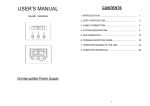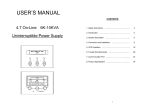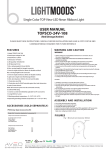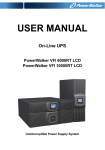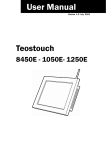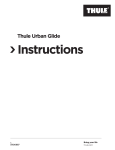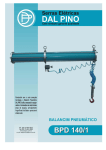Download USER'S MANUAL - PowerWalker UPS
Transcript
USER’S MANUAL PowerWalker VFI 1000 / 3000VA CONTENTS 1. INTRODUCTION .............................................……........ 1 2. SAFTY INSTRUCTION...................……...…………….... 2 3. SYSTEM DESCRIPTION..........................……......…..... 4 4. CABLE CONNECTION ..............................…….......…... 7 5. OPERATION ................................................……........... 8 6. TROUBLE SHOOTING GUIDE.......................…….....… 13 7. OPERATION MODES OF THE UPS ..............……........ 17 8. COMPUTER INTERFACE ...........................……........... 19 9. SPECIFICATIONS.................................…………..…..... 21 Uninterruptible Power Supply 1 1. INTRODUCTION 2. SAFTY INSTRUCTION 1.1 General Description 2.1 Transporting The continuity of electrical power is an essential requirement for critical load 1. Disconnect all power cables if necessary. operations. The Uninterruptible Power System (UPS) is designed to meet the 2. Be careful not to damage the UPS while transporting. user‘s need of present computer, server and the equipment of office 3. Don‘t move the UPS upside down. automation that make the UPS more compact and less noisy. 4. Please transport the UPS system only in the original packaging (to protect To choose the UPS as your equipment protector is a wise investment because it supplies reliable, pure and stable power at affordable price. 1.2 Key features against shock and impact). 2.2 Positioning 1.Do not put the UPS on rugged or declined surface. 1. Multiple microprocessor and double-conversion design base. 2. Wide input range designed to operate under harsh environment. 3. High input power factor and DC-start function. 4. LED and LCD display for detail status and data; real-time alarm silence. 5. Enhanced protections against light, surges, and disturbance etc. 6. Remote monitoring with SNMP intelligent slot and RS-232 interface. 7. Light weight and compact size, easy to transport and place. 1.3 Important Notices 2.Do not install the UPS system near water or in damp environments. 3.Do not install the UPS system where it would be exposed to direct sunlight or near heat. 4.Do not block off ventilation openings in the UPS system’s housing and don’t leave objects on the top of the UPS. 2.Allow a minimum distance of 10 cm in the rear and two sides of the UPS for ventilation. 4.Keep the UPS far away from heat emitting sources. To be sure that the UPS will be operated correctly, the following items should 6.Do not expose it to corrosive gas. be noticed: 1. Read instructions carefully before operating the UPS. 2. UPS power connect instruction should be followed. 7.Ambient temperature : 0℃ - 40℃ 2.3 Installation 3. Please don‘t open the case to prevent danger. 1. Connect the UPS system only to an earthed shockproof socket outlet. 4. If the UPS will be stored for long period, the battery must be charged once 2. Do not connect domestic appliances such as hair dryers or office equipment every 90 days. which would overload the UPS system (e.g. laser printers) to UPS output 5. Retain the load within the rating of UPS to prevent faults. 6. Handle unusual events according to the trouble-shooting guide. sockets. 3. Place cables in such a way that no one can step on or trip over them. 7. Keep the UPS clean and dry. 2 3 3. SYSTEM DESCRIPTION 2.4 Operation 1. Do not disconnect the mains cable on the UPS system or the building wiring socket outlet during operations since this would cancel the protective 3.1 LCD Display(Includes detachable LCD function with connecting from remote control port to RS-232) earthing of the UPS system and of all connected loads. 2. The UPS has its own internal power source (batteries). The output terminals may be live even when the UPS is not connected to the AC supply. 3. Ensure that no fluids or other foreign objects can enter the UPS system. 2.5 Maintenance and Service 1. Caution - risk of electric shock. Even after the unit is disconnected from the mains power supply (building wiring socket outlet), components inside the UPS system are still connected to the battery and are still electrically live and dangerous. Before carrying out any kind of servicing and/or maintenance, disconnect the batteries and verify that no current is present. 2. Only persons adequately familiar with batteries and with the required precautionary measures may exchange batteries and supervise operations. Unauthorised persons must be kept well away from the batteries. 3. Batteries may cause electric shock and have a high short-circuit current. Please take the precautionary measures specified below and any other measures necessary when working with batteries: - remove wristwatches, rings and other metal objects - use only tools with insulated grips and handles. 4. When changing batteries, install the same number and same type of batteries. 5. Do not attempt to dispose of batteries by burning them. This could cause battery explosion. 6. Do not open or destroy batteries. Escaping electrolyte can cause injury to the skin and eyes. 1. LCD Display: This indicates the UPS operation information, including UPS status, input/output voltage, input/output frequency, battery voltage, battery capacity left, output load, inside temperature, and the times of history events. 2. LCD Select Up-key: It is pressed to select upward the UPS status on LCD Display. 3. LCD Select Down-key: It is pressed to select downward the UPS status on LCD Display. When UPS is in operation press this key and the LCD Select Up-key simultaneously for 3 seconds, the UPS will be switched off after two beeps. 4. Control Key: When this key is pressed with the LCD Select Down-key simultaneously for 3 seconds, the UPS will be switched on after two beeps. Similarly. Beside, in battery operation mode, press both of this key and LCD Select Up-key at the same time to disable the buzzer. 4 5 5. Fault LED (red): To indicate the UPS is in fault condition because of inverter shutdown or over-temperature. 6. Warning LED (yellow): To indicate the UPS is in the status of overload, bypass and battery back-up. 5~9. Load & Battery Capacity LEDs: (a) No. 5 to 8 LED is green color and No. 9 (used as warning LED for overload or battery low) is yellow. 7. Normal LED (green): To indicate the UPS is operating normally. (b) These LEDs show the load % of the UPS if the mains power is available (in normal operation). LEDs light up to indicate the following information. 3.2 LED Display No. 5 LED: 0-35 % No. 5&6&7&8 LEDs: 76-95 % No. 5&6 LEDs: 36-55 % No. 5&6&7&8&9 LEDs: 96-105% No. 5&6&7 LEDs: 56-75 % (c) In the battery operation, the LEDs indicate the capacity (%) of the batteries. LEDs light up to indicate the following information. No. 9 LED: 0%-25 % (battery low level) No. 8&9LEDs: 26%-50 % No. 6&7&8&9 LEDs: 76%-95 % No. 7&8&9 LEDs: 51%-75 % No. 5&6&7&8&9 LEDs: 96-100 % 10. Fault LED (red): To indicate the UPS is in fault condition because of inverter shutdown or over-temperature 11. On/Test/Mute key: It should be pressed with the control key (see the following item 12) simultaneously to do UPS auto test and turn off the buzzer when in battery operation. 1. Line LED (green): To indicate the AC power is applied to the UPS input. In case this LED blinks, it means the main AC source is out of tolerance. 2. Bypass LED (yellow): To indicate the load is powered via the bypass. 3. Battery LED (yellow): To indicate the UPS is in battery backup mode when the mains power has failed. 4. Inverter LED (green): To indicate the UPS is powered through inverter. 6 12. Control Key: (a) When this key is pressed with the On/Test/Mute key simultaneously for 3 seconds, the UPS will be switched on after two beeps. (b) When UPS is in operation, press this key and On/Test/Mute/ key simultaneously, the UPS will do auto battery test. And the Battery LED will blink if the battery may have problem. Besides, in battery operation 7 (buzzer beeps), press this key and the On/Test/Mute key at the same 2KVA / 3KVA Tower Case time to disable the buzzer. (c) When UPS is in operation this key is pressed with the Off key simultaneously for 3 seconds, the UPS will be switched off after two beeps 13. Off key: It should be pressed with the control key (see the above item 12) simultaneously to switch off the UPS. 3.3 Outline Description 1KVA Tower Case FRONT VIEW SIDE VIEW BACK VIEW 8 9 2KVA / 3KVA Tower Case 3.4 Back View Description 1KVA Tower Case 1. DB 9 (RS-232) Interface Port 6. Fan 2. SNMP Intelligent Slot (Option) 7. External Battery Socket 1. DB 9 (RS-232) Interface Port 7. External Battery Socket 2. SNMP Intelligent Slot (Option) 8. Fan 3. Fax / Modem (Surge Protection) 9 Breaker 4. Remote Control 3. Fax / Modem (Surge 8. Breaker Protection) 10. Input Terminal (Detachable LCD Panel) 5. Output Socket (NEMA or IEC) 4. Remote Control 9. Input Socket (Detachable LCD Panel) 6. Output Terminal 5. Output Socket (NEMA or IEC) 10 11 4. CABLE CONNECTION 5. OPERATION 5.1 Check Prior to Start Up 4.1 Inspection 1. The system may be installed and wired only by qualified electricians in accordance with applicable safety regulations. 2. When installing the electrical wiring, please note the nominal amperage of 1. Ensure the UPS is in a suitable positioning. 2. Check input cord is secured. 3. Make sure the load is disconnected or in the “OFF” position. 4. Check if input voltage meets the UPS rating required. your incoming feeder. 3. Inspect the packaging carton and its contents for damage. Please inform 5.2 Operation Procedure the transport agency immediately should you find signs of damage. Please follow the instructions below for the UPS operation. Please keep the packaging in a safe place for future use. 1. Once the AC source is connected, the 4. Please ensure that the incoming feeder is isolated and secured to prevent it from being switched back on again. LCD Display shall light up immediately to display first the main menu of greeting context and the Normal LED is 4.2 Connection blinking to indicate ready to switch on 1. UPS Input Connection If the UPS is connected via the power cord, please use a proper socket with protection against electric current, and pay attention to the capacity of the inverter. 2. By pressing the UPS on/off Control Key and the LCD Select Down-key simultaneously for 3 seconds until the buzzer beeps twice, the UPS will the socket. start up and Normal LED lights up to indicate the power is from its inverter 2. UPS Output Connection The output of this model is with socket-types only (NEMA or IEC). Simply plug the load power cord to the output sockets to complete connection. to the load. 3. When the LCD Select Down-key and the LCD Select Up-key are pressed simultaneously for 3 seconds until the buzzer beeps twice, the inverter will be turned off and the UPS is on the standby status (LCD display illuminates and Normal LED is blinking) until AC source is disconnected. 5.3 Storage Instruction Disconnect input power in rear panel if you will not use it for long period. If the UPS is stored over 3 months, please keep supplying power to the UPS for at least 24 hours to ensure battery fully recharged. 12 13 5.4 LCD Display Use Up/Down key to select menu-displays of the LCD described below. This 5. Battery Status Menu screen will refresh once the system power is enabled. 2. Status Menu 1. Rated Spec Menu 6. Output Power Menu 7. Temperature Menu 3. Voltage Menu 8. History Record Menu 4. Frequency Menu 14 15 10. Output Voltage Set Menu 9. Bypass Range Set Menu A. In this screen, press on/off A. To protect the load, the function of bypass auto-transfer is Control Key to enter the following steps for output voltage setting. activated only when the AC main voltage is within the range of LO (low) and HI(high). In this screen, press on/off Control Key to enter the following steps for LO/HI voltage setting. B. The cursor (→ ) will pop up to indicate the output voltage newly selected. B. The cursor (→ ) will pop up to indicate the item newly selected. Press on/off Control Key to get the item of LO or HI range the C. Use Up or Down-key to adjust the output voltage (220V, 230V, and 240V are available only). user want to adjust. D. Once the correct voltage is C. Use Up or Down-key to adjust the voltage (changing 1V by selected, press on/off Control Key again to save the data. every press). LO (low rang):176V+/- 20V, HI(high range):253V+/- 20V). D. Once the value is confirmed, press on/off Control Key again to save the data. 16 17 6. TROUBLE SHOOTING GUIDE 3. LED and LCD status as below: 6.1 UPS Status and Action The description of the following guideline may be helpful in problem solving. 1. LED and LCD status as below: UPS STATUS: AC utility power is normal but UPS is overloaded. Warning LED lits up and buzzer beeps per second. UPS STATUS: AC utility power is normal. UPS is running normally, but battery ACTION: Please reduce the critical load to POWER(%)<100%. capacity is low (referring to Battery Status Menu). Buzzer beeps once 4. LED and LCD status as below: every second for battery low. ACTION: Charger may broke down. Please replace charger board. 2. LED and LCD status as below: UPS STATUS: AC utility power is normal but UPS is overloaded up to 125%. Warning LED does not fade out and buzzer beeps per 0.5 second. UPS STATUS: AC utility power is normal. The output load is supplied through bypass ACTION: Please reduce the critical load to POWER(%)<100%. of AC utility. Fault LED lits up and buzzer beeps continuously. ACTION: Please contact your agent for service. 18 19 5. LED and LCD status as below: 7. LED and LCD status as below: UPS STATUS: UPS STATUS: AC utility fails. The load is supplied by UPS in backup mode, and AC utility power is normal, but the load is supplied by AC utility power via bypass. Output power is more than 150% (referring to the Output Power Menu). Warning LED lits up and buzzer beeps continuously. battery power is approaching low level. Buzzer alarm beeps every second. ACTION: UPS will shut down automatically. Please save data soon. ACTION: Please reduce the critical load to POWER(%)<100%. 8. LED and LCD status as below: 6. LED and LCD status as below: UPS STATUS: AC utility power fails and battery runs out. UPS has shut down UPS STATUS: AC utility power fails .The full load is supplied by battery power in UPS. Buzzer alarm sounds every 4 seconds. ACTION: If AC utility power fails, reduce the less critical load in order to extend backup time. If it is not abnormal power failure, please check automatically. ACTION: UPS will restart up when AC utility power is restored. If AC utility power failure is more than 6 hours, please follow storage instruction. the rated input or connected line. 20 21 7. OPERATION MODES OF THE UPS 7.3 AC Utility Failure The AC output comes from battery, passing through DC/AC inverter and 7.1 UPS System Block Diagram static switch within the battery backup time. 7.2 Normal Operation There are two main loops when AC utility is normal: the AC loop and the 7.4 Bypass Enable battery charging loop. The AC output power comes from AC utility input and Under the following conditions, the bypass will be enabled: passes through AC/DC rectifier, DC/AC inverter and static switch to support 1.Overload. power to load. The battery charging voltage comes from AC utility input and 2.Inverter failure. converted by AC/DC charger to support battery-charging power. 3.Over-temperature 22 23 8.2 DB9 Interface Connector 8. COMPUTER INTERFACE 8.1 communication interface The communication interface (DB9 port) on the back of the UPS may be connected to a host computer. The port provides communicating with the computer like below. Supply RS-232 for monitoring software of UPSilon 2000 The UPS communicates with the computer by sending out RS-232 data DB9 INTERFACE CONNECTOR DB9 PIN Assignment streams to one of the serial ports. By this method the user is able to monitor the following parameters. PIN 2: RS232 RXD PIN 3: RS232 TXD Input Voltage Indicates the present input voltage to the UPS system when AC power is present. Output Voltage Indicates the present output voltage of the UPS. AC Frequency Indicates the actual output frequency of the UPS. Battery Voltage Temperature PIN 5: GND The other PINs have no function. Indicates the present DC voltage of the UPS battery. Indicates the actual temperature inside the UPS. 24 25 9. SPECIFICATIONS Rated Power Capacity 1KVA / 700W Voltage Input 2KVA / 1400W 140~300Vac at 50~70% load, 118~300Vac at 0~50% load Frequency 50Hz or 60Hz +/- 4Hz ≧ 0.95 Power Factor Output Voltage, Frequency Single phase 220Vac +/- 2% (230V or 240V re-settable via LCD panel), 50Hz or 60Hz Transient Response +/- 3% (100% load variation) Waveform / Distortion Sine wave, THD < 3% at 0-100% linear load Crest Ratio Battery Voltage (longer backup time is available upon request) Charger Transfer Time 3:1 7Ah / 12V * 3pcs 5 hrs to 90% of full capacity after full load discharge Battery low shutdown and Fuse Overload 125~150% 30sec, then switch to bypass and auto re-transfer; >150% for 200ms Short Circuit Current Limited and cut-off and fuse and breaker EMI/EMC EN50091-2 Mains Failure Audible Alarm Beeping every 4 seconds Battery Low Beeping once every second Fault, Overload LCD LED Normal (green), Warning (yellow), Fault (red) LED DB9 Connector Network Continuously UPS status, I/P&O/P voltage& frequency, Battery voltage, Battery capacity, Loading %, Temperature, History record Indicator Communications SNMP Intelligent Slot RS-232 Interface; Power monitoring software (Option) Power management from SNMP manager and Web browser (Option) RJ11 I/O port available for 10 base-T network Surge Protection or Fax / Modem Temperature Environment 0-40 degree C; 32-104 degree F Relative Humidity 0-95% non-condensing Acoustic Noise Physical 7Ah / 12V * 8pcs AC fail 0 ms; 2.5ms typical from inverter to bypass and vice versa Battery Protection 3KVA / 2100W Single phase 220Vac, 160~300Vac at 70~100% load Less than 45dBA (at 1 meter) Net Weight (w/o batt.) 7kgs 13.5kgs 14.5kgs Net Weight (w/ batt.) 14kgs 34kgs 35kgs Dimension (WxHxD)mm 160x220x400 ※ Specifications are subject to change without notice. 26 200x352x450















